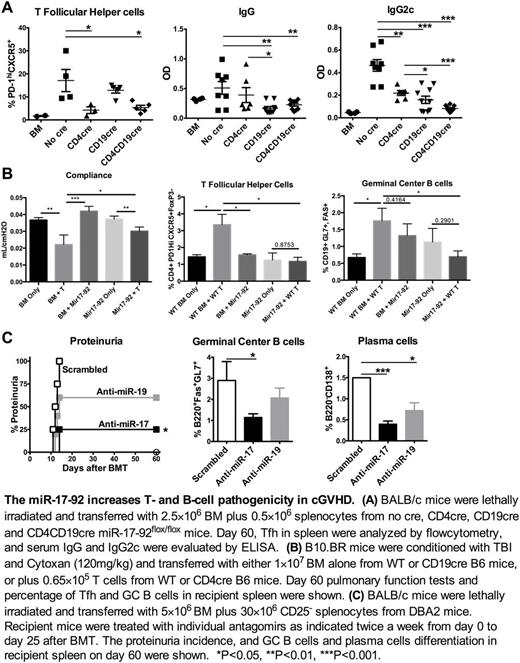Abstract
Chronic graft-versus-host disease (cGVHD) remains to be a major cause of mortality and morbidity after allogeneic hematopoietic cell transplantation (allo-HCT). cGVHD is characterized as autoimmune-like fibrosis and antibody production, mediated by pathogenic T and B cells. Through producing pro-inflammatory cytokines, CD4 T cells are the driving force of cGVHD. Donor B cells augment the pathogenesis of cGVHD not only by acting as antigen-presenting cells (APCs) and promoting CD4 T-cell expansion and survival, but also by producing autoantibodies. microRNA (miR)-17-92 has been shown to regulate T-cell immunity including allogeneic, anti-viral, and anti-tumor responses. Recently, miR-17-92 was found to act together with Bcl-6 to promote the differentiation of Follicular help T (Tfh) cells. Furthermore, B-cell deficiency of miR-17-92 impairs IgG2c production. Since Tfh differentiation and antibody production are required for the development of cGVHD, we hypothesize that miR-17-92 contributes to the pathogenesis of cGVHD by promoting pathogenic T- and B-cell responses.
By using Cre-loxp system, we generated B6 mice with conditional deficiency of miR-17-92 in T cells (CD4cre), B cells (CD19cre), or both (CD4CD19cre). aGVHD to cGVHD transition model (B6 to BALB/c) was utilized to test the effects of individual and combinational deficiency of miR-17-92 in T and/or B cells in the development of cGVHD. BALB/c mice were lethally irradiated and transferred with splenocytes plus BM cells derived from CD4cre, CD19cre or CD4CD19cre miR-17-92flox/flox B6 mice. WT B6 (Cre- miR-17-92flox/flox) mice were used as control donors. A significantly reduction of GVHD mortality was observed only in the recipients with CD4CD19cre grafts, but not with CD4cre or CD19cre grafts. Deficiency of miR-17-92 in donor T or B cells indeed improved the clinical manifestation of cGVHD, but the deficiency in both T and B cells showed further improvement, indicating the additive role of miR-17-92 in T and B cells in the pathogenesis of cGVHD. Mechanistically, deficiency of miR-17-92 in T cells resulted in the reduction of Tfh generation (Fig. A), germinal center (GC) B-cell and plasma cell differentiation, and the expression of MHC-II and CD86 on donor B cells in recipient spleens. Furthermore, deficiency of miR-17-92 in B cells significantly reduced the levels of total IgG and IgG2c in recipient serum (Fig. A). These data suggest that miR-17-92 contributes to both T- and B-cell differentiation and function, which is required for the development of cGVHD.
To extend our findings, we used a bronchiolitis obliterans cGVHD model (B6 to B10.BR). Recipient mice were pre-conditioned and received either BM alone from WT or CD19cre B6 mice, or BM plus purified T cells from WT or CD4cre B6 mice. Deficiency of miR-17-92 in T cells or BM-derived B cells resulted in significant improvement in pulmonary functions in recipient mice, as demonstrated by a decrease in resistance and elastance and an increase in compliance (Fig. B). Consistently, we found that miR-17-92 promoted Tfh and GC B-cell differentiation (Fig. B), while inhibiting differentiation of T follicular regulatory cells in recipient spleens 60 days after allo-HCT.
For translational purpose, we tested whether inhibition of miR-17-92 could ameliorate cGVHD using locked nucleic acid (LNA) antagomirs specific for miR-17 or miR-19, key members in this microRNA cluster. In a SLE cGVHD model (DBA2 to BALB/c), administration of anti-miR-17, but not anti-miR-19, significantly suppressed the incidence of proteinuria and the severity of clinical manifestation by inhibiting donor splenocyte expansion, expression of costimulatory molecules on donor B cells, and differentiation of GC B cells and plasma cells (Fig. C). In addition, systemic delivery of anti-miR-17 significantly improved skin cGVHD by restraining IL-17 producing CD4 T-cell infiltration in skin-draining lymph nodes in a scleroderma-cGVHD model (B10.D2 to BALB/c).
Taken together, the current work reveals that miR-17-92 is required for T- and B-cell differentiation and function, and thus for the development of cGVHD. Furthermore, pharmacological inhibition of miR-17 represents a potential therapeutic strategy for the control of cGVHD after allo-HCT.
No relevant conflicts of interest to declare.
Author notes
Asterisk with author names denotes non-ASH members.


This feature is available to Subscribers Only
Sign In or Create an Account Close Modal